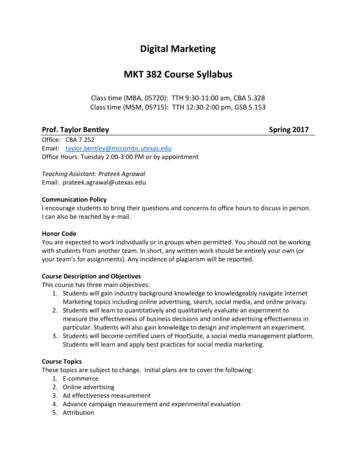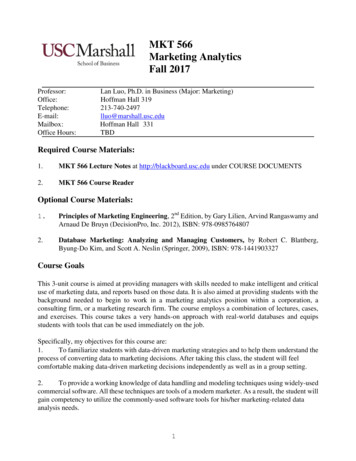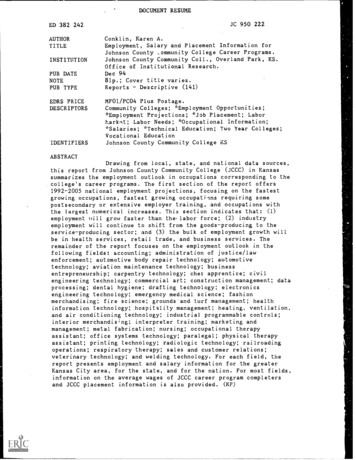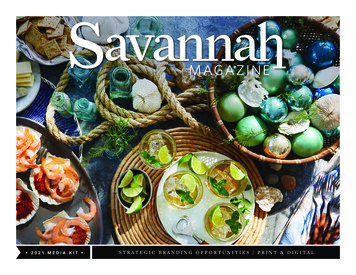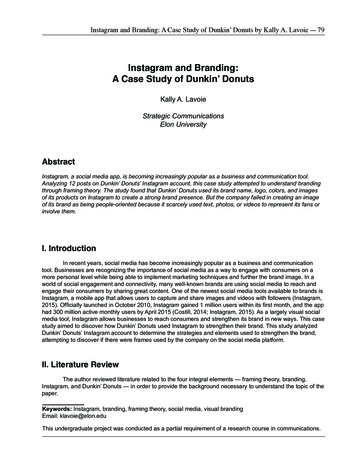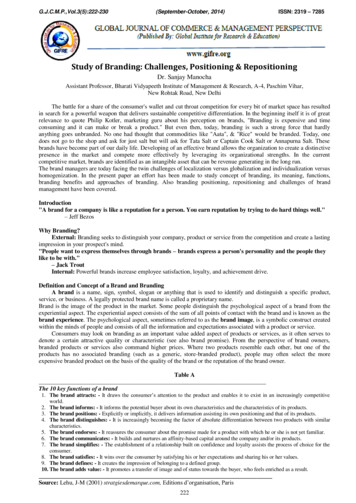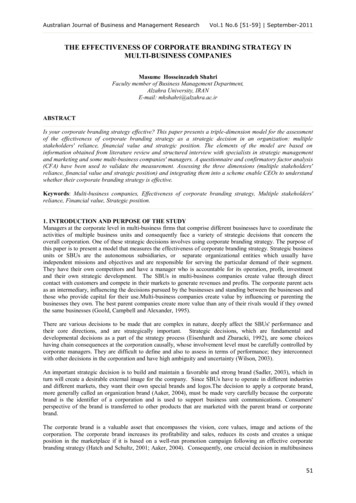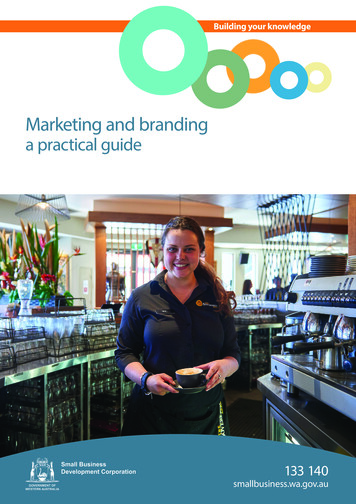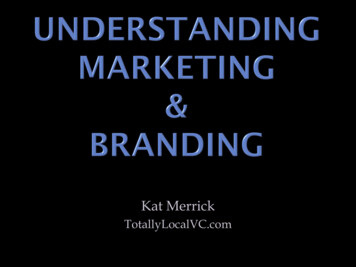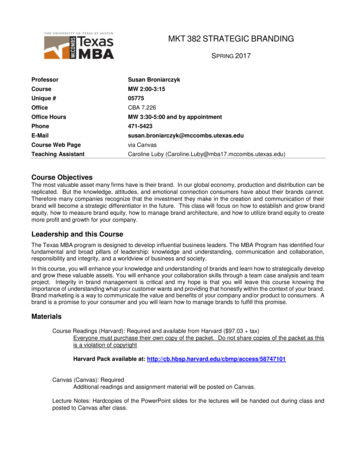
Transcription
MKT 382 STRATEGIC BRANDINGSPRING 2017ProfessorSusan BroniarczykCourseMW 2:00-3:15Unique #05775OfficeCBA 7.226Office HoursMW 3:30-5:00 and by combs.utexas.eduCourse Web Pagevia CanvasTeaching AssistantCaroline Luby (Caroline.Luby@mba17.mccombs.utexas.edu)Course ObjectivesThe most valuable asset many firms have is their brand. In our global economy, production and distribution can bereplicated. But the knowledge, attitudes, and emotional connection consumers have about their brands cannot.Therefore many companies recognize that the investment they make in the creation and communication of theirbrand will become a strategic differentiator in the future. This class will focus on how to establish and grow brandequity, how to measure brand equity, how to manage brand architecture, and how to utilize brand equity to createmore profit and growth for your company.Leadership and this CourseThe Texas MBA program is designed to develop influential business leaders. The MBA Program has identified fourfundamental and broad pillars of leadership: knowledge and understanding, communication and collaboration,responsibility and integrity, and a worldview of business and society.In this course, you will enhance your knowledge and understanding of brands and learn how to strategically developand grow these valuable assets. You will enhance your collaboration skills through a team case analysis and teamproject. Integrity in brand management is critical and my hope is that you will leave this course knowing theimportance of understanding what your customer wants and providing that honestly within the context of your brand.Brand marketing is a way to communicate the value and benefits of your company and/or product to consumers. Abrand is a promise to your consumer and you will learn how to manage brands to fulfill this promise.MaterialsCourse Readings (Harvard): Required and available from Harvard ( 97.03 tax)Everyone must purchase their own copy of the packet. Do not share copies of the packet as thisis a violation of copyrightHarvard Pack available at: vas (Canvas): RequiredAdditional readings and assignment material will be posted on Canvas.Lecture Notes: Hardcopies of the PowerPoint slides for the lectures will be handed out during class andposted to Canvas after class.
BroniarczykMKT 382 Strategic Branding—Spring 2016page 2Course PhilosophyMy basic teaching philosophy for this course is to blend the theory and practice of product and brand managementin a comfortable, supportive classroom environment that promotes active learning. A good theory is invaluablebecause it structures problems and suggests possible solutions. My view is that the most critically importantconsideration in branding is understanding the customer, hence many theories covered will be from aconsumer behavior perspective.Branding is both an art and a science. Thus, few branding situations have a definitive, unqualified answer as to the“best” marketing programs. Yet, my belief is that by providing you with relevant and comprehensive theories, andall the accompanying ideas, concepts, mechanisms, and models that go along with that, you can make moreinformed decisions that will have a greater probability of success.The course readings and activities are designed to help blend theory and practice. The readings will cover the basicconcepts and theoretical frameworks as well as provide current thinking on key topics. Cases will allow us to applythese theories to real marketing problems. Guest speakers will be used to illustrate current brand issues and thetension between theory and practice.Each member of the class is a key part of the learning process. We learn from the insights and experiences ofeach other. I expect you to come to class prepared, ask questions and participate, and be respectful of your fellowstudents.Course Requirements and GradingYour grade in the course will be determined as follows:PointsCase Applications40Case Analysis120In-Class Contribution100Team Brand Meaning Audit I: Interviews & Twitter 35Team Brand Inventory35Team Final Project and Presentation110440Grade Basis:A 93-100%A- 90-92%B 87-89%B 83-86%B- 80-82%C 77-79%C 73-76%C- 70-72%D 67-69%D 63-66%D- 60-62%F below 60%Re-grading. Requests to have a grade reconsidered should be submitted in writing. If you would like to submit arequest, or if you would just like to discuss your grade in general, wait at least 48 hours after an assignment isreturned to you. This timing will facilitate a rational, objective discussion of the merits of the case. No re-gradingwill be considered more than 10 days after the assignment is returned to you, unless it is a matter of a math error,which will always be cheerfully corrected.
BroniarczykMKT 382 Strategic Branding—Spring 2016page 3Description of RequirementsCase Applications (2@20 points each 40 points)Case applications are one page, typed (single-spaced,1” margins, 12-point type). Submit one copy with noidentification via Canvas and one hard copy at the beginning of class. Each assignment is worth 20 points.Samsung: Assess and compare Samsung’s brand equity using Keller’s CBBE pyramid, for the U.S. versusChina.Dove: Write 3 positioning statements. The first positioning statement is for Dove in the 1950’s. The secondpositioning statement is for Dove in 2007. The third positioning statement is for yourself. The positioningstatements should be in the following format:Positioning Statement:Product/BrandIs Unique and Most Important ClaimAmong All Competitive FrameFor Target MarketBecause Support, Reasons WhyCase Analyses (3@40 points each 120 points)Your top 3 case analyses from the following 4 cases will count toward your final grade:Ford FiestaGiant Consumer ProductsDieselAdobeAppendix A contains case analysis decision and case preparation questions to reflect on as you renderyour decision for each case.The format for the case analysis is a two-page recommendation regarding the case decision. The first page issingle-spaced (1” margins, 12-point type) written case recommendation. The second page is an appendix page ofpros and cons and supporting evidence and analyses. See Appendix B for suggested case analysis format.A written case recommendation is a formal proposal submitted to management. When writing a case analysis,consider the following points:1)Your recommendation needs to be very tightly argued. You may use “bullet” point form for part ofyour argument. However, be careful not to be too cryptic.2)Do not simply restate data from the case. The CEO is already familiar with the business!3)On the other hand, take every opportunity to support your arguments with case data. Askyourself, “Is there any objection the boss could raise that I have not already overcome?” Then doyour best to overcome it.4)Provide supporting evidence from analysis of case data in Appendix.) Crunch the numbers tosupport your points (e.g., sales have increased by X%, brand awareness has declined by X%).Show how your recommendation is more profitable than alternative recommendation(s). It isassumed that you have mastered marketing financial analyses in your McCombs MBA core.The Ford Fiesta case analysis may be completed with a partner or individually. All other case analyses(Giant Consumer Products, Diesel, Adobe) are individual assignments and should be worked onindependently (i.e., no discussion with a classmate). Case discussions and analyses are restricted to materialpresented in the case. Do NOT incorporate any material from outside the case in your analyses. Each case analysiswill be worth a maximum of 40 points. Submit one copy with no identification via Canvas and one hard copyat the beginning of class. Any associated EXCEL files should be submitted to Canvas prior to class.
BroniarczykMKT 382 Strategic Branding—Spring 2016page 4In-Class Contribution (100 points)In-Class Contribution. In-class contribution is evaluated on the quality of your participation and its contribution toimproving the learning experience of the class. Note that quality is not necessarily a function of quantity. Youwill be evaluated according to the following guidelines:Outstanding (3): Contributions provided major insights as well as a fruitful direction for the class. Argumentswere well-supported (with tangible evidence) and persuasively presented. If this person were not a memberof the class, the quality of the class discussion would have been significantly diminished.Good (2): Contributions were on-target, fairly well supported and persuasive. If this person were not amember of the class, the quality of the discussion would have been slightly diminished.Attending Non-participant (1): Contributed nothing to the class discussion. A person attends class but issilent and does not participate in the class’ discussion.Repetitive (0): If a person’s class comments were repetitious and obvious and did not add value to theclass. That is, you will be penalized for “airtime” without value.Unsatisfactory (-1): Unsatisfactory contribution occurs if inadequate preparation. If this person were not amember of the class, the quality of the discussions would have been enhanced.Absent or Late (-1): Obviously, one cannot participate if one is absent from the course. Absences areseverely frowned upon. You are granted two (2) absences (i.e., free pass) so use them wisely (illness,interviews) between January 18 – April 19. After that, if due to extenuating circumstances, you mustmiss class, a one page executive summary of that session’s readings and cases must be submittedprior to the class to receive a comparable credit for attending non-participant (1 point), otherwise theparticipation points for that day will be –1. A person who disrupts the class by coming in late will receive a–1 participation points.Note attendance at brand audit presentations (April 24 – May 3) is mandatory. First, you benefit fromthe brand learnings and insights of your classmates. Second, your classmates benefit from your input asyour ratings of the presentations will factor into their presentation grades. Absence from a brand auditpresentation day will be penalized -3.Final in-class contribution grade will be determined by a curve with median class contributor receiving agrade of 90 points and typical distribution between 80-100 points. Several updates on your participationpoints will be provided during the semester.Brand AuditSelf-selected teams consisting of 5 members will conduct a brand audit. The goal of the brand audit is to conductan in-depth examination of a major brand of your choosing and suggest ways to improve and leverage that brandequity. The criteria for choosing a brand lies in: 1) the brand’s interest/value to you, 2) consumers’ likelyfamiliarity with the brand, 3) access to the brand’s target market, 4) access to brand and companyinformation, and 5) brand presence in social media conversations. To insure that every team starts on equalfooting, you may not select a brand that a team member or their family has worked for. Selecting a brandundergoing a challenge regarding its brand architecture, brand portfolio, brand extension, or brand revitalizationgenerally provides greater fodder for critique. Every team must study a different brand. A good source of possiblebrands is Jan. 30 readings (“Best Global Brands 2016:Interbrand,” “BrandZ Top 100 Most Valuable Global Brands”).For family or corporate brands, consider a specific product brand in order to narrow your focus and provide a specificframe of reference and competition (e.g., Toyota Camry rather than overall Toyota brand). Brands examined inpast projects have spanned the spectrum from retail, CPG, tech, service, and non-profit brands. For instance,Spring 2016 audits examined the following brands: Barnes & Noble, Chipotle, Coach, ESPN, GAP, JCrew,Lululemon (Note these brands are not eligible for Spring 2017).All Brand audit deliverables should be e-mailed prior to class to Canvas.
BroniarczykMKT 382 Strategic Branding—Spring 2016page 51. Team Brand Selection (0 Points; Feedback Provided)The first installment of the brand audit is due on Wednesday, February 8 by 8am. In a 2-3 page Worddocument, teams need to notify me regarding team membership and the top three brands you are interestedin studying and their associated challenge. This deliverable is not graded; however investing effort here inbrand selection will pay huge dividends in a quality final brand audit project. The deliverable is to:1) Identify team members2) Rank order the top three brands your team is interested in for the brand audit project.3) For each brand:a. Identify two (2) challenges the brand is facingb. Each challenge should be supported with research evidence from at least two (2) references.c. References should follow appropriate APA citation format (see BB posting)2. Brand Meaning Audit: Preliminary Consumer Exploratory using ZMET, In-Depth Interviews, & SocialMedia (35 points)This second installment of the brand audit is due on Wednesday, February 22. Its purpose is to help youunderstand the brand through the eyes of the consumer: what does the brand mean; where does it stand?This exploration into the brand’s meaning serves a foundational role in your brand planningrecommendation as it defines current sources of brand equity and suggests areas for improving orleveraging that equity.This project deliverable has four components:1) Each team will complete a minimum of 4 ZMET and 4 in-depth laddering interviews. Completetranscripts of these interviews including scanned images from ZMET should be included in aWord appendix. Interview questions and answers in bullet form are OK as long as they capturecomplete insight.2) Monitor social media comments on your brand for at least a 7-day period on Twitter and one othersocial media platform most relevant for your brand (Facebook, Instagram, Pinterest, Snapchat, etc
Samsung: Assess and compare Samsung’s brand equity using Keller’s CBBE pyramid, for the U.S. versus China. Dove: Write 3 positioning statements. The first positioning statement is for Dove in the 1950’s. The second positioning statement is for Dove in 2007. The third positioning statement is for yourself. The positioning statements should be in the following format: Positioning Statement .
